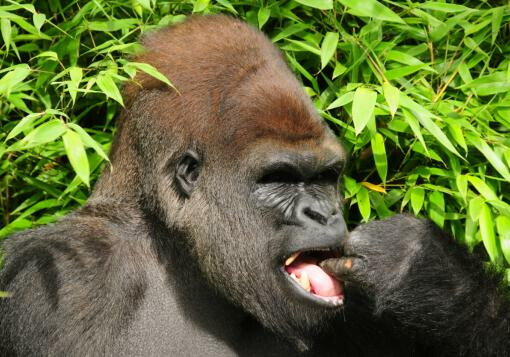Spitting Image

An article in World Magazine discusses a published paper in the journal, Molecular Biology and Evolution, which studied the saliva of humans verses gorillas, chimps and macaque monkeys.
A recent study in the journal Molecular Biology and Evolution identified one small but significant difference between humans and apes: their spit. The results enlarge the widening gap observed between humans’ and nonhuman primates’ physiology. The scientists studied the saliva of humans alongside two species they believe are closely related—chimpanzees and gorillas—looking for unique features. They also included Rhesus macaque monkeys as an “outgroup,” or unrelated species, for comparison. While chimpanzees and gorillas have very similar saliva, human spit has a distinct composition, the researchers found. The amounts of different proteins in the human samples differed markedly from the ape samples, and the human saliva contained proteins that didn’t exist at all in gorillas, chimps, or macaques. Human spit was also waterier. “Certain properties and components of human and nonhuman primate saliva might have evolved in a lineage-specific manner,” the studies’ authors wrote. Though they suggested evolutionary pressures like diet and disease could have caused the differences, they did not rely on evolutionary theory or say their findings supported it in any way. They only examined and described differences. The researchers said the trends they observed “raise the possibility that salivary protein profiles of humans may be more unique than expected solely based on phylogenetic distances of species.” If humans and apes were related as closely as evolutionary theory suggests, their saliva is more different than expected. While evolutionary biologists hunt for similarities between humans and apes, this study adds to the physiological differences that researchers have identified over the years. The gentle, shapeshifting evolutionary journey from apes to humans often illustrated in museums cannot bridge the vast physical gulf between the species. On the podcast ID the Future, biologist Ann Gauger, a researcher with Discovery Institute, listed the many complicated biological systems that function differently in humans and chimpanzees, which evolutionists believe are our closest animal relatives. Neither the reproductive systems nor teeth nor thyroid and metabolism function nor immune systems nor brain structure and development work the same way in humans and chimps. Gauger pointed out that chimps differ so much from humans that the National Institutes of Health advised against using them as models in medical research. The list of more obvious anatomical differences was just as long, and that’s to say nothing of the self-evident behavioral differences. “The list goes on and on,” she concluded. “Our capabilities are orders of magnitude beyond anything a chimp can do.”SCIENCE | Saliva study highlights differences between apes and humans
by Rachel Lynn Aldrich
Posted 11/14/19, 04:36 pm
